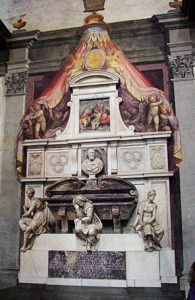Legacy
Michelangelo’s Legacy
Michelangelo, with Leonardo da Vinci and Raphael, is one of the three giants of the Florentine High Renaissance. Although their names are often cited together, Michelangelo was younger than Leonardo by 23 years, and older than Raphael by eight. Because of his reclusive nature, he had little to do with either artist and outlived both of them by more than forty years. Michelangelo took few sculpture students. He employed Francesco Granacci, who was his fellow pupil at the Medici Academy, and became one of several assistants on the Sistine Chapel ceiling. Michelangelo appears to have used assistants mainly for the more manual tasks of preparing surfaces and grinding colours. Despite this, his works were to have a great influence on painters, sculptors and architects for many generations to come.
While Michelangelo’s David is the most famous male nude of all time and destined to be reproduced in order to grace cities around the world, some of his other works have had perhaps even greater impact on the course of art. The twisting forms and tensions of the Victory, the Bruges Madonna and the Medici Madonna make them the heralds of the Mannerist art. The unfinished giants for the tomb of Pope Julius II had profound effect on late-19th- and 20th-century sculptors such as Rodin and Henry Moore.
Michelangelo’s foyer of the Laurentian Library was one of the earliest buildings to utilise Classical forms in a plastic and expressive manner. This dynamic quality was later to find its major expression in Michelangelo’s centrally planned St Peter’s, with its giant order, its rippling cornice and its upward-launching pointed dome. The dome of St Peter’s was to influence the building of churches for many centuries, including Sant’Andrea della Valle in Rome and St Paul’s Cathedral, London, as well as the civic domes of many public buildings and the state capitals across America.
Artists who were directly influenced by Michelangelo include Raphael, who imitated Michelangelo’s prophets in two of his works, including his depiction of the great master in the School of Athens. Other artists, such as Pontormo, drew on the writhing forms of the Last Judgement and the frescoes of the Capella Paolina.
The Sistine Chapel ceiling was a work of unprecedented grandeur, both for its architectonic forms, to be imitated by many Baroque ceiling painters, and also for the wealth of its inventiveness in the study of figures. Vasari wrote:
The work has proved a veritable beacon to our art, of inestimable benefit to all painters, restoring light to a world that for centuries had been plunged into darkness. Indeed, painters no longer need to seek for new inventions, novel attitudes, clothed figures, fresh ways of expression, different arrangements, or sublime subjects, for this work contains every perfection possible under those headings.

